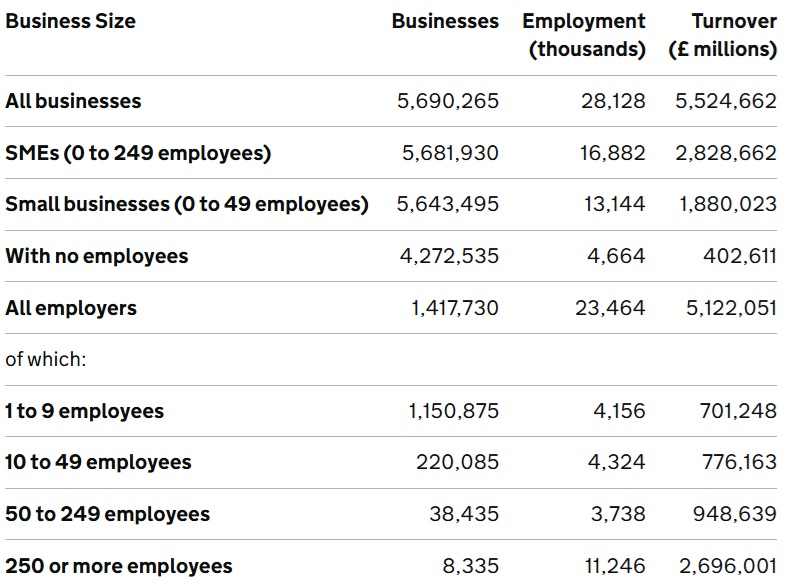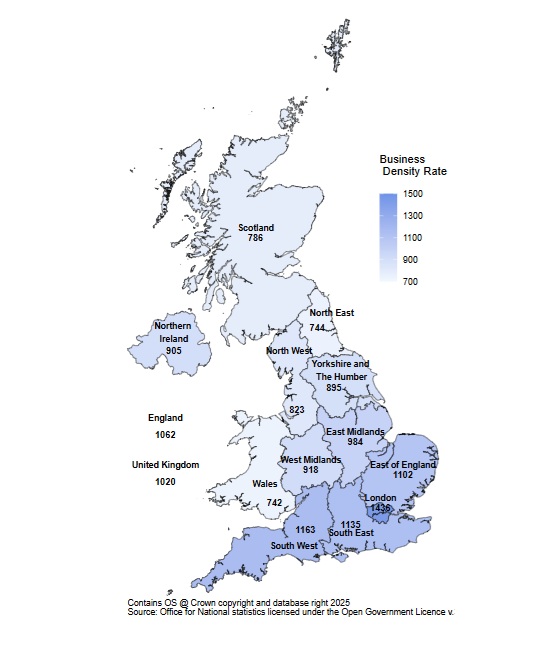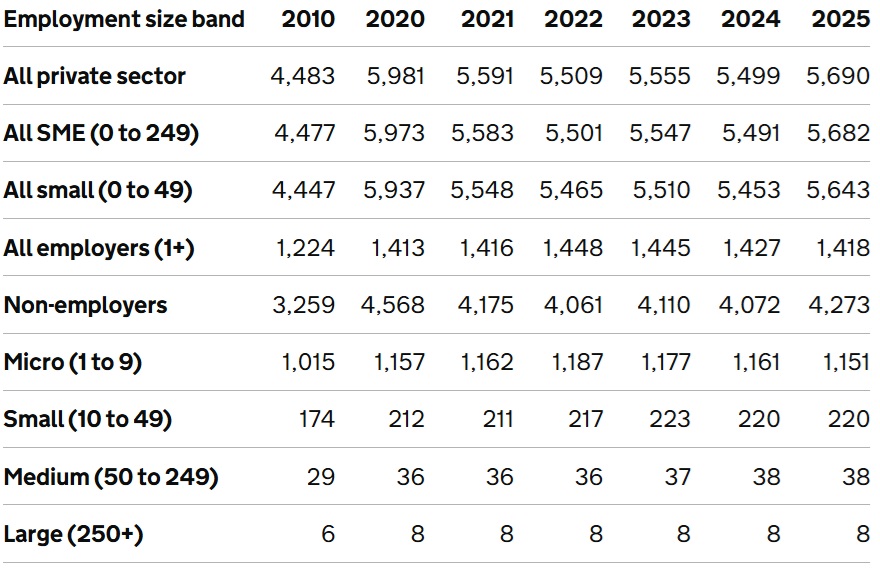The total number of businesses in the UK at the start of 2025 increased by 191,000 to 5.7 million compared to the start of 2024, official figures have revealed.
Releasing the new business population statistics, the Department for Business and Trade said the reason behind the rise was the number of employing businesses decreasing by 9,000 (0.7%), but the number of non-employing businesses rising by 201,000 (4.9%).
The 5.7 million was made up of the following:
- 1.4 million (25%) businesses had employees and 4.3 million (75%) did not employ anyone aside from the owners.
- 5.64 million small businesses (with 0 to 49 staff), 99.18% of the total business population.
- 38,435 medium-sized businesses (with 50 to 249 staff), 0.67% of the total business population.
- 8,335 businesses were large businesses (with 250 or more staff), 0.15% of the total business population.
Estimated number of businesses in the UK private sector and their associated employment and turnover, by size of business, start of 2025:

The increase in non-employing businesses was made up of a rise of 174,000 (6.1%) in unregistered businesses, and an increase in non-employing registered businesses of 27,000 (2.2%).
Between 2024 and 2025, the number of limited companies rose by 40,200 (2%), sole traders increased by 138,900 (5%) and ordinary partnerships saw a hike of 12,200 (3%).
Total employment across all private sector businesses increased from 27.8 million to 28.1 million, up 1.3%, while total employment in SMEs rose from 16.6 million to 16.9 million, an increase of 1.5%. The SME share of total employment remains at 60%.
For regional statistics, private sector businesses increased by 206,000 in England, 6,000 in Scotland and 6,000 in Northern Ireland. There was a decrease of 26,000 in Wales.
In percentage terms, numbers of private sector businesses rose by 4% in England, by 2% in Scotland and 4% in Northern Ireland. Numbers decreased by 12% in Wales.
The number of private sector businesses increased in eight of the nine English regions, with London the English region with the largest numeric increase (59,000), followed by the East of England (51,000) and the East Midlands (45,000). The largest percentage increase was in the East Midlands (13%).
The South East was the only English region with a decrease since 2024. It fell by 30,000 (3%).
The business population statistics report said that in all regions and countries, changes were driven largely by changes in numbers of unregistered businesses.
Number of businesses in the UK private sector per 10,000 adults, UK region and country, start of 2025:

By industry, SMEs account for at least 99% of the overall population in each of the main industry sectors, so the report said they “determine the distribution of the business population overall”.
The largest number of SMEs (885,000 or 16%) were operating in construction, compared with less than 1% in the mining, quarrying and utilities sector (28,000)
There were also a large numbers of SMEs operating in the professional, scientific and technical activities (819,000 or 14%), and wholesale and retail trade (547,000 or 10%).
Trends in business population statistics
Between 2010 and 2025:
- the total business population has increased by 1.2 million (26.9%).
- business numbers increased from 4.5 million in 2010 to a peak of 6.0 million at the start of 2020, prior to the COVID-19 pandemic and the UK withdrawal from the European Union.
- the highest rate of increase was 6.8% between 2013 and 2014, followed by 5.0% between 2011 and 2012.
- in contrast, the decrease of 6.5% between 2020 and 2021 is the largest year-on-year decrease in the series since 2010.
- numbers of registered businesses increased by 524,000 (24.7%).
Between 2020 and 2025:
- the total business population decreased by 290,000 (4.9%).
- numbers of employing businesses increased by 5,000 (0.4%), while non-employing business numbers decreased by 295,000 (6.5%).
- the decrease in non-employing businesses resulted from a decrease of 283,000 (8.5%) unregistered businesses and a decrease in non-employing registered businesses of 12,000 (1.0%).
- numbers of all registered businesses decreased by 7,000 (0.3%)
Estimated number of businesses (in thousands) in the UK private sector by employment size band, start of 2010, and 2020 to 2025:



